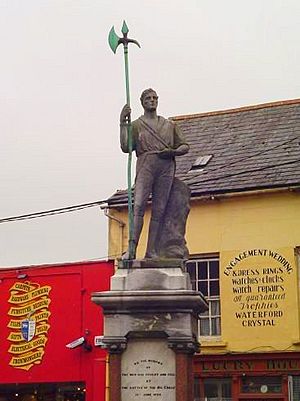Battle of the Big Cross facts for kids
Quick facts for kids Battle of the Big Cross |
|||||||
|---|---|---|---|---|---|---|---|
| Part of the Irish Rebellion of 1798 | |||||||
 Monument to United Irish commander Tadhg an Astna O'Donovan in Clonakilty |
|||||||
|
|||||||
| Belligerents | |||||||
| Commanders and leaders | |||||||
| Sir Hugh O'Reilly | Tadhg an Astna O'Donovan † | ||||||
| Strength | |||||||
| Unknown | Unknown | ||||||
| Casualties and losses | |||||||
| Unknown | 50-100 | ||||||
The Battle of the Big Cross was an important fight during the Irish Rebellion of 1798. It happened on June 19, 1798, in County Cork, Ireland. This battle was between Irish rebels, called the United Irishmen, and government soldiers. It took place near Clonakilty at a spot known as the "Big Cross." This was the only major battle of the rebellion in County Cork.
Contents
Why the Battle Happened
The Irish Rebellion of 1798 was a big uprising against British rule in Ireland. Before this battle, the government was worried about a French invasion fleet arriving in Bantry Bay in 1796. Because of this, many soldiers were sent to West Cork. These soldiers included regular troops, local militia, and yeomanry.
Searching for Weapons
In early 1798, Major-General Sir John Moore led about 3,000 soldiers in West Cork. The government told everyone to hand over their weapons by May 2nd. If they did, they would not be punished.
During these searches, soldiers were told to be firm with people. They also took food they needed. Sir John Moore tried to stop bad things from happening during these searches. However, many people were still very scared of the soldiers.
By May 23rd, most weapons had been collected in West Cork. Soldiers found many pikes (a type of spear) and firearms. Many people thought to be United Irishmen were arrested. Even though other parts of Ireland, like Wexford, were rebelling, West Cork stayed quiet for a while.
Irish Soldiers in the British Army
It's interesting that many government soldiers in West Cork were Irish Catholics. Some of these soldiers might have even secretly supported the United Irishmen. This made the situation even more complex.
The Battle Unfolds
On June 18, 1798, a group of soldiers called the Westmeath Militia was in Clonakilty. Their leader, Lieutenant-Colonel Sir Hugh O'Reilly, got orders to move his troops to Bandon.
Morning of the Battle
Early on June 19, the Westmeath Militia started marching. They had two cannons with them. As they marched, they met a group of 300 to 400 United Irishmen rebels. These rebels were mostly local farmers and had few weapons.
The rebels were led by a man named Tadhg an Astna O'Donovan. They met at the "Big Cross" crossroads.
A Short Fight
Stories say that O'Donovan tried to get the Irish soldiers in the Westmeath Militia to join the rebels. However, the soldiers fired their guns instead. Sir Hugh O'Reilly, the British commander, said this didn't happen.
The fight was short. The United Irishmen had very few firearms and were quickly defeated. Another group of Scottish soldiers, called the Caithness Legion, also attacked the rebels.
Between 50 and 100 rebels were killed. Tadhg an Astna O'Donovan, the rebel leader, was among them. The government troops had very few casualties.
After the Battle
After the battle, soldiers brought the bodies of the dead rebels to Clonakilty town. They were left in front of the market house for several days. Later, they were moved to a local spot now called the Croppy Hole. Relatives of the rebels later found and buried them.
The government then put up signs in both Irish and English. These signs told local people to give up their leaders and weapons. They also asked people to go back home and start working again.

